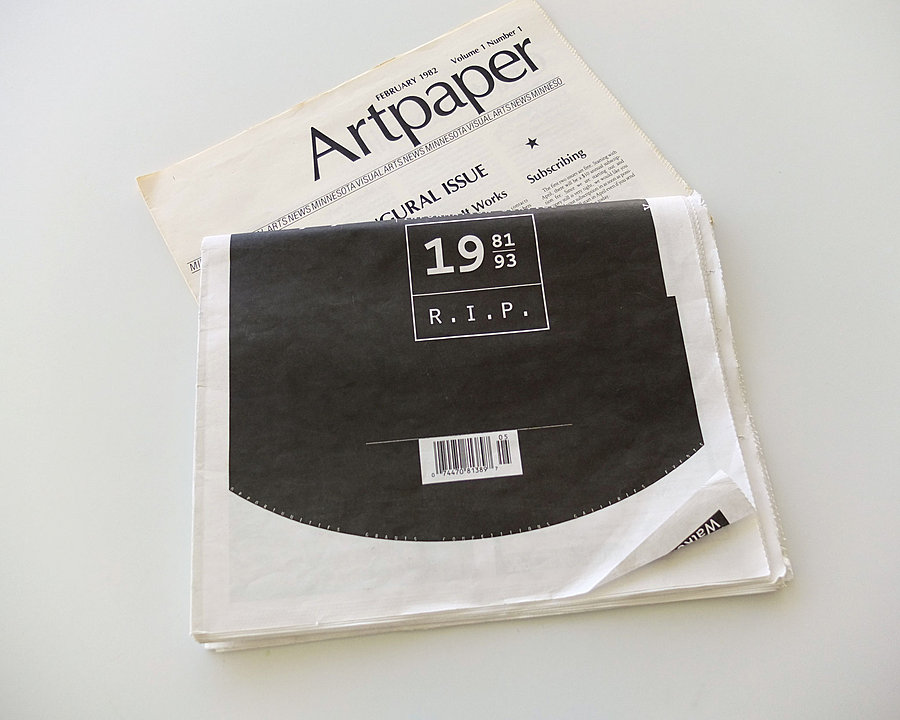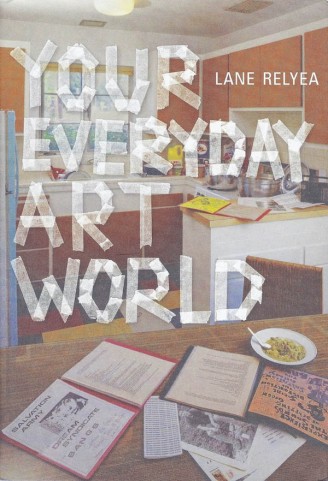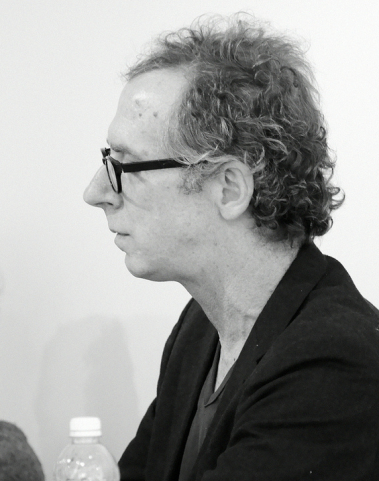
The crowd that squeezed into Midway on November 12 to hear Lane Relyea’s talk, “Subjects of the Institution of Art,” could easily have filled the auditorium at the Walker, but Relyea’s message would have felt dulled had it been ensconced in such an “institution.” Midway’s library was a particularly apt setting for Relyea’s thought-provoking discussion. This gallery library is an exemplary iteration of the “your” in Relyea’s recent book Your Everyday Art World, in which he explores the burgeoning trend for art spaces at every level to multiply platforms for interaction and greater opportunity for feedback loops with their visitors. It’s worth noting that this alternative art space, once housed in St. Paul’s Midway area, actually reduced the square footage for its gallery to accommodate its library’s expansion, literally opening up more of its dedicated physical space to written intellectual discourse around visual art in an effort to foster more back-and forth conversation between viewer, artist and art object.
But Lane Relyea’s presence in the library was symbolic and powerful for other reasons, too. See, Relyea was here, in Minneapolis, at a particularly fertile time in our cities’ creative history — the late ’80s and early ’90s. I was here, too, caught in the fringes of the era’s creative skirts as a punked-out teenager, one of many who were filing into neighborhood basements, garages, and various and sundry other alternative spaces made available to us. And Relyea was at the center of that scene, writing and editing Artpaper, a local publication which put a serious critical cast on the DIY activity sprouting around him.
He has since stayed true to these roots, noting over the years the perverse ways in which neo-liberal capitalist mechanisms have corporatized this earlier era’s DIY fervor into the ideal “prosumer” — today’s in-flux, self-reliant, hyper-flexible ideal worker. These mythical free agents work for themselves outside of the establishment, contracting and piece-mealing their many gigs and professional roles together in an unstable mix of a, wait… This sounds an awful lot like what every artist has to do today to develop and maintain their artistic persona. Relyea’s recent work ingeniously shows how the current conception of the ideal worker resembles an artist, now more than ever before. He even notes Daniel Fisk’s argument that the MFA is the new MBA, articulated in the book Free Agent Nation, as creativity and entrepreneurship more closely align.
At first, it might seem that Relyea is just another critical voice upset at how a fractured economic landscape has left so many of us to despair of doing better, interminably in desperate straits. But he brings to that discussion a welcome nuance, thoughtful insights into how one might navigate the many layered strata of the art world. He’s less interested in assigning blame for a failing system than he is in illuminating the ways all its various cogs and wheels function simultaneously. But make no mistake: this is no Seven Days in the Art World. Your Everyday Art World looks far outside what Relyea would call the Fordist model (i.e. the system by which artwork passes through various hands – dealers, collectors, museum curators and collections – to be packaged as an elite, luxury good). It has traditionally been the gatekeepers — critics and dealers — who seize upon the work of emerging artists (almost exclusively functioning in the NY/LA axis) and usher them into success. But we now operate in a post-Fordist society, one dominated by large horizontal networks — meaning this current market system can easily be superseded and chart already how it is becoming less dominant.
This is where small, radiant beams of light fall through the cracks in the art system, especially in “far-flung sites of production” like the Twin Cities. This new, decentralized system, Relyea argues, has the potential to overtake the outmoded critic/dealer model through a convergence of several key developments — one of which is the increasing importance of networks that help art move beyond objectification to prioritize fostering connections between artists, audiences and discourses. In the end, he says, art subjects emerge out of such interactions, and these art subjects also feed back into the work itself. Thus the art, as object, cannot be isolated, aloof or proscribed from those interactions. Despite the imperative for these burgeoning art networks to be rooted in a scene of artists and interested parties coalescing together, geography hardly matters. The site of such interactions can be set in any remote locale and still be relevant to the larger cultural conversations.
You simply can’t discount the rising tide of people, the sheer number of artists rolling out of the 270 MFA programs in the US, he says. (Fun fact: he tested the audience, challenging us to guess which state has no MFA program; I thought Alaska, but it is, in fact, Wyoming). This new wave of highly educated, creative workers cannot be absorbed by the elite, dealer/critic paradigm. Rather, they appear to be rejuvenating the DIY spirit of their underground forbearers, producing art subjects (and objects) worthy of note and also well outside the usual coastal axis of cultural influence.
The net effect of this activity, Relyea says, is the creation of a “federation of systems” — far-flung, geographically remote scenes that do not fit into the usual gallery complex, in places like Kansas City, San Francisco, Minneapolis, New Orleans or, his example, the art space, Elsewhere, in Greensboro, N.C. This loose coalition of artists and independent spaces has many drivers — it is a highly inclusive system where creative value is invested in links, connections and interfaces. It’s no accident that this is the same terminology used in new media networks: this is the system of the future. And our local art scene, here in the Twin Cities, is poised to be a major player within it. Indeed, the increased decentralization of these new cultural systems favor the literal center, the American Midwest, as notions of value shift further from discreet art objects given attention by high-end art magazines which, until now, haven’t much bothered with work made in “flyover” country.
Relyea highlighted a particular federation, Common Field, a newly formed umbrella by which disparate art spaces, organizations, and free agents (Relyea included) work in concert and mutually support each other. Notably, this network also includes the Soap Factory, the largest contemporary art exhibition space in the US (which, incidentally, finally got the nod from New York for their insanely popular and populist Haunted Basement) and Works Progress, a progressive creative placemaking organization without a brick-and-mortar anchor — both of which will host the next Hand in Glove conference in Minneapolis, September 17–20, 2015.
Sure, there is a utopian feel to all this, but Relyea seems to be making the case that artists are hardy, robust activators with everything they need to make stuff happen — with or without funding, 501(c)(3) status or not. For Relyea, no cash sales are needed, because it is people, art subjects and artists, who replenish the scene. This more generous, people-focused conception of artistic worth eradicates the necessity for product differentiation, opening the possibility for a greater equality in market value, too. By this measure, all work is valuable in so far as it endeavors to support the whole. We especially need to remember this utopian ideal, he’s saying, in our overstretched, workaday artistic lives, where making time to create discrete objects feels less meaningful than setting aside space to create connections between art subjects.
I know, I’m barely skimming the surface of what Relyea’s premise means to Minnesota artists. In keeping with the aim of producing and integrating art subjects, I welcome your feedback, response and further dialogue to my recap of Relyea’s recent talk. I’m especially curious to hear from you who also went to the lecture at Midway. What’s your take on these issues raised in Relyea’s visit? And did you know: this website, Mn Artists, was originally developed to fill in the gap Artpaper left when it folded? (For more on that history, see Neal Cuthbert’s interview for the Walker from a couple of years ago.)
Related links and event information:
Another lecture in this vein is coming soon: David Joselit, author of After Art, will discuss “Heritage and Debt” and further consider how contemporary art functions within globalized networks. Joselit will speak in the Walker Cinema, December 3 at 7 p.m. The event is free and open to the public.
Sheila Dickinson is a St. Paul native and wrote her first art review of a Shane Cullen exhibition at the Orchard Gallery in Derry, Northern Ireland, a key DIY artspace in another remote art location that Relyea highlights in his book Your Everyday Art World. She wrote her dissertation on contemporary Irish art at University College, Dublin.
Get Walker Reader in your inbox. Sign up to receive first word about our original videos, commissioned essays, curatorial perspectives, and artist interviews.

